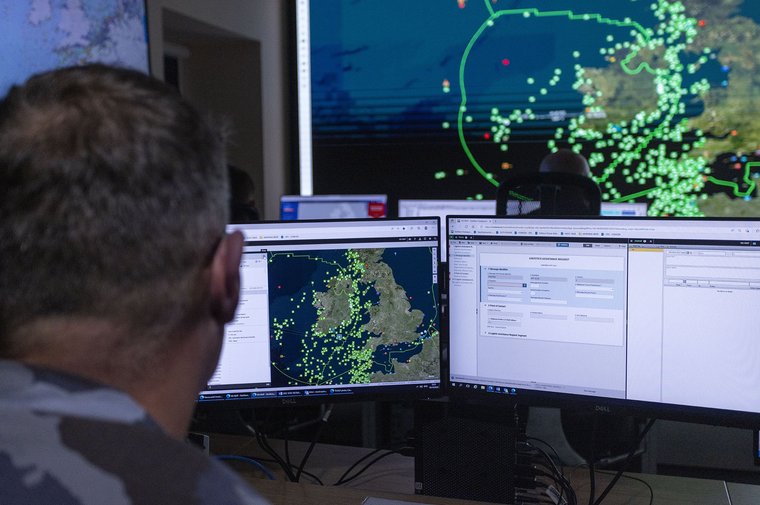Details
More Products & Services
Products & Services
Military Unmanned Systems Handbook
Shephard Media
The Military Unmanned Systems Handbook (Digital Download) is an international guide to the military UV industry and provides detailed information on air, ground and sea (surface & sub-sea) vehicles as well as subsystems. What's included: Unencrypted 390+ page PDF of equipment and supplier information Market summary
Shephard Plus Update
Shephard Media
Shephard Plus is updating in June 2018 with rich new capabilities, and is now one of the most cost-effective and valuable aerospace and defence market intell...
Defence Insight
Shephard Media
Some of the things people like you use Defence Insight for:
- Total addressable market sizing ($)
- Competitor analysis
- Cost analysis
- Market forecasting
- Growth identification
- Increasing closing ratio
- Increasing closing order value
- Estimating product potential
- Calculating sales forecasting
- Supply and demand analysis
- Total addressable market sizing ($)
- Competitor analysis
- Cost analysis
- Market forecasting
- Growth identification
- Increasing closing ratio
- Increasing closing order value
- Estimating product potential
- Calculating sales forecasting
- Supply and demand analysis
Description
This article is brought to you by Systematic
While the open sea may look vast and empty to those standing watch, there can be a myriad of friendly, civilian, and enemy assets operating above and below the waterline that need to be taken into consideration when naval vessels are operating.
Monitoring and tracking vessels, aircraft, and other above-water objects is made easier by a combination of radar systems and open-source data feeds, such as ADS-B and AIS. Monitoring subsurface objects, ranging from submarines to undersea infrastructure, has some different requirements. Operating in conjunction with friendly submarine forces means effective management of the subsurface space, knowing a submarine's location and planned movements to avoid interference and maximise intelligence gathering and dissemination efforts.
WaterSpace Management (WSM) facilitates the coordination of sub-surface warfare aimed at locating and engaging enemy submarines and other sub-surface vehicles. This capability also ensures a synchronised deployment of weapons among own submarines, surface ships, and aircraft. WSM operates within various designated areas with specific purposes, including specific WSM areas designated for either exclusive submarine use or a combination of forces, submarine patrol areas, and no-attack areas.
“WaterSpace Management is a critical capability for the safe coordination of the movements of submarine and underwater vessels,” said Stig Meyer, Product Manager for SitaWare Maritime.
“That's why we have paid particular attention to this aspect. Now operators can create a moving haven for the area in which a submarine will operate, and pin that to a pre-planned route. This will automatically calculate the position of the submarine as it travels by calculating the distance and speed.
“This then becomes visible for all users of SitaWare, informing their situational awareness and allowing them to plan their own movements safely and effectively. It's an important feature in the software and one that we think our customers will greatly benefit from as a result.”
This functionality means that operators can now import APP-11 subnotes, allowing them to visualise planned submarine movements directly on the map. This enhances operational planning by providing a clear, real-time view of submarine operations alongside other maritime assets.
Joint operations from a single screen
SitaWare Maritime takes together a wide variety of sensor inputs in multiple formats - including OTH-Gold, APP-11, AIS, Link 16, MIP, and more - and helps to fuse them into a single screen. Utilising map layers, maritime operations staff can gather intelligence from across domains to build an information-rich situational overview, make key operational decisions, and ensure that intelligence is shared across all domains to a wide variety of users.
This capability helps to reduce the stovepipes that can be created between maritime and land commanders, particularly when undertaking amphibious operations or when leveraging maritime assets and capabilities to deliver effects against air and ground targets.
The ability to relay the view from a deployed ship additionally means that on-the-scene commanders can share their planned intentions with senior commanders ashore; thereby reducing the role of the “long-handled screwdriver” in maritime operational command.
Intelligence-led decision making
SitaWare Maritime also utilises SitaWare Fusion, a plug-in that performs correlation and analysis of sensor tracks to ensure that full data fidelity of objects in the operating environment. When multiple sensors pick up an object and track it, SitaWare Fusion helps to de-duplicate, while providing redundancy in case a sensor loses contact with an object of interest.
Leveraging this track correlation and fusion capability, users are also able to set up alerting for objects or activities of interest. This can range from suspicious contacts between vessels, the presence of vessels in areas where they may otherwise not normally operate, or deviation from standard courses. The creation of an alerting system means that commanders can be made aware of potential threats and changes to the RMP as early as possible.
Click here to find out more about SitaWare Maritime, or listen to our recent podcast on Submarines and C2 here.
While the open sea may look vast and empty to those standing watch, there can be a myriad of friendly, civilian, and enemy assets operating above and below the waterline that need to be taken into consideration when naval vessels are operating.
Monitoring and tracking vessels, aircraft, and other above-water objects is made easier by a combination of radar systems and open-source data feeds, such as ADS-B and AIS. Monitoring subsurface objects, ranging from submarines to undersea infrastructure, has some different requirements. Operating in conjunction with friendly submarine forces means effective management of the subsurface space, knowing a submarine's location and planned movements to avoid interference and maximise intelligence gathering and dissemination efforts.
WaterSpace Management (WSM) facilitates the coordination of sub-surface warfare aimed at locating and engaging enemy submarines and other sub-surface vehicles. This capability also ensures a synchronised deployment of weapons among own submarines, surface ships, and aircraft. WSM operates within various designated areas with specific purposes, including specific WSM areas designated for either exclusive submarine use or a combination of forces, submarine patrol areas, and no-attack areas.
“WaterSpace Management is a critical capability for the safe coordination of the movements of submarine and underwater vessels,” said Stig Meyer, Product Manager for SitaWare Maritime.
“That's why we have paid particular attention to this aspect. Now operators can create a moving haven for the area in which a submarine will operate, and pin that to a pre-planned route. This will automatically calculate the position of the submarine as it travels by calculating the distance and speed.
“This then becomes visible for all users of SitaWare, informing their situational awareness and allowing them to plan their own movements safely and effectively. It's an important feature in the software and one that we think our customers will greatly benefit from as a result.”
This functionality means that operators can now import APP-11 subnotes, allowing them to visualise planned submarine movements directly on the map. This enhances operational planning by providing a clear, real-time view of submarine operations alongside other maritime assets.
Joint operations from a single screen
SitaWare Maritime takes together a wide variety of sensor inputs in multiple formats - including OTH-Gold, APP-11, AIS, Link 16, MIP, and more - and helps to fuse them into a single screen. Utilising map layers, maritime operations staff can gather intelligence from across domains to build an information-rich situational overview, make key operational decisions, and ensure that intelligence is shared across all domains to a wide variety of users.
This capability helps to reduce the stovepipes that can be created between maritime and land commanders, particularly when undertaking amphibious operations or when leveraging maritime assets and capabilities to deliver effects against air and ground targets.
The ability to relay the view from a deployed ship additionally means that on-the-scene commanders can share their planned intentions with senior commanders ashore; thereby reducing the role of the “long-handled screwdriver” in maritime operational command.
Intelligence-led decision making
SitaWare Maritime also utilises SitaWare Fusion, a plug-in that performs correlation and analysis of sensor tracks to ensure that full data fidelity of objects in the operating environment. When multiple sensors pick up an object and track it, SitaWare Fusion helps to de-duplicate, while providing redundancy in case a sensor loses contact with an object of interest.
Leveraging this track correlation and fusion capability, users are also able to set up alerting for objects or activities of interest. This can range from suspicious contacts between vessels, the presence of vessels in areas where they may otherwise not normally operate, or deviation from standard courses. The creation of an alerting system means that commanders can be made aware of potential threats and changes to the RMP as early as possible.
Click here to find out more about SitaWare Maritime, or listen to our recent podcast on Submarines and C2 here.

Share
Recent Chats
Share via email
Future: handle WhatsApp here
Future: handle LinkedIn here
Future: handle Twitter here
SUBMENU HERE
Share via Chat
Copy Link



